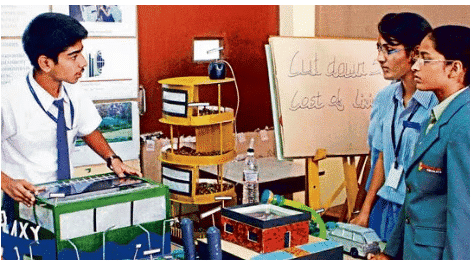Vocational Education Chapter Notes | Communicative English for Class 10 PDF Download
| Table of contents |

|
| Key Points of the Story |

|
| Detailed Summary |

|
| Theme/ Message |

|
| Difficult Words |

|
Key Points of the Story
- The chapter introduces Rohan, who is not interested in traditional professional courses.
- Students are encouraged to find alternative courses that Rohan may enjoy, using a word maze as a fun activity.
- The chapter emphasizes the importance of vocational education, which focuses on practical skills for specific jobs.
- Vocational education is often seen as non-academic and is usually offered at secondary or post-secondary levels.
- There is a growing need for vocational training to meet the skill demands of the economy and to improve employability.
- Vocational education can create more job opportunities and foster entrepreneurial skills among learners.
- Despite its benefits, many students lack motivation to pursue vocational education due to societal attitudes.
- Parents and educators often hold rigid views against vocational courses, considering them less valuable.
- Some vocational courses are outdated, lacking relevance to current job markets and industries.
- There is a disconnect between vocational training institutions and the needs of the private sector, leading to employment challenges for graduates.
- Globalization has introduced new job sectors that require skilled workers, such as hospitality, fashion, and information technology.
Detailed Summary
Vocational education aims to equip students with the skills and knowledge required for specific trades or occupations, often available at secondary or post-secondary levels. Its significance is increasing due to the high demand for skilled workers in various industries, which helps prepare students for immediate employment after their training. This pathway offers students a viable opportunity to earn a living and support themselves.
Rohan, like many students, may find vocational courses appealing because they promise direct job opportunities. The chapter encourages exploration of vocational options such as plumbing, welding, and electrical work, all of which are hands-on jobs that are in demand in today's job market.
Following the identification of courses, the chapter includes a matching activity where students connect various jobs with their profiles and categories. For instance, a fitter specializes in plumbing installations, while a machinist operates machinery to make parts. This activity aids in understanding job roles and their respective fields, including technology, commerce, and agriculture.

Despite the advantages of vocational education, challenges persist. Many students lack motivation to choose these courses, often viewing them as inferior to academic options. Similarly, some parents and educators hold outdated beliefs that vocational education is not a legitimate pathway for learning or earning a living.
Another significant issue is the obsolescence of some vocational courses, where outdated skills are taught that no longer meet current job market needs. For example, courses teaching skills for non-existent jobs leave students unprepared for employment. Additionally, a disconnect between vocational training schools and industries creates obstacles for students in securing good jobs post-training.
With globalization, new job opportunities continue to arise in sectors like hospitality, fashion technology, film and television, information technology, retail, and healthcare. These fields demand skilled workers trained in specific tasks. Therefore, vocational education is crucial in providing students with the necessary skills to thrive in these evolving industries. The chapter stresses the need for educational systems to adapt and offer courses that align with the current job market, ensuring students are prepared for the workforce.
In conclusion, the chapter addresses the various facets of vocational education and its benefits for students like Rohan. It underscores the importance of practical skills, identifies challenges within vocational education, and emphasizes the necessity for adaptation in response to the changing job market. By recognizing these elements, students can make informed choices about their educational and career paths.
Theme/ Message
- The theme of the chapter revolves around the significance of vocational education in today's job market.
- It highlights the need for practical skills and training that align with current industry demands.
- The chapter conveys the message that vocational education can lead to better employment opportunities.
- It encourages a shift in perspective for parents and educators to recognize the value of vocational courses.
- The message also stresses the importance of updating vocational programs to match the evolving job landscape.
- Ultimately, vocational education is portrayed as a vital pathway for individuals seeking meaningful careers.
Difficult Words
- Vocational: Related to skills and training for a specific job or trade.
- Entrepreneurial: Relating to the ability to start and manage a business.
- Motivation: The reason or desire to do something.
- Obsolete: No longer used or relevant; outdated.
- Linkage: A connection or relationship between two or more things.
- Globalization: The process where businesses develop international influence or operate on an international scale.
- Manpower: The supply of people who are available to work.
- Employability: The quality of being suitable for paid work.
- Emerging: Coming into existence or becoming prominent.
- Hospitality: The friendly and generous reception and entertainment of guests.
- Technology: The application of scientific knowledge for practical purposes.
- Skills: The abilities or expertise needed to perform a task.
- Manual: Involving physical work or the use of hands.
- Practical: Concerned with actual doing or use of something rather than with theory and ideas.
- Industry: Economic activity concerned with the processing of raw materials and manufacturing of goods.
|
8 videos|250 docs|8 tests
|
FAQs on Vocational Education Chapter Notes - Communicative English for Class 10
| 1. What is the importance of vocational education for students? |  |
| 2. How does vocational education differ from traditional education? |  |
| 3. What are some common vocational programs available for students? |  |
| 4. What role do internships play in vocational education? |  |
| 5. How can students benefit from pursuing vocational education alongside traditional schooling? |  |














